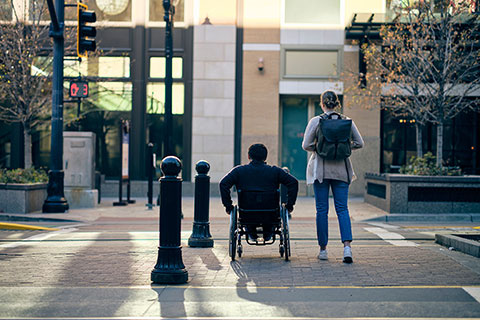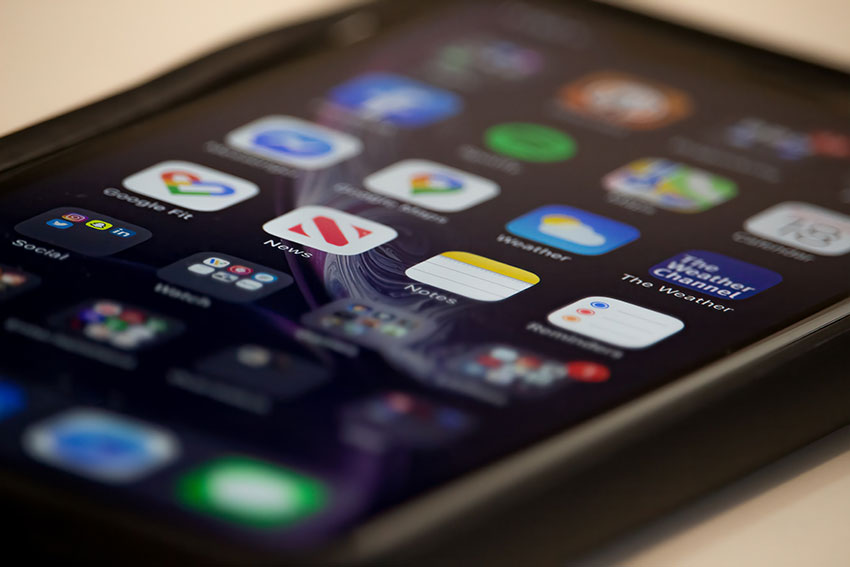By Alice Skipton
UW CREATE collaborates toward a world with fewer problems and more solutions for people of all abilities.

CREATE researchers and partners work on high-impact projects — such as those focused on mobility and on mobile device accessibility — advancing the inclusion and participation for people with disabilities.
According to the Centers for Disease Control and Prevention (CDC), one in four people in the United States lives with a disability. “The presence of disability is everywhere,” says Heather Feldner, UW Medicine assistant professor in Rehabilitation Medicine and associate director with the UW Center for Research and Education on Accessible Technology and Experiences (CREATE). “But how disability has been constructed, as an individual problem that needs to be fixed, leads to exclusion and discrimination.”
The construct also ignores the reality that people's physical and mental abilities continually change. Examples include pregnancy, childbirth, illness, injuries, accidents and aging. Additionally, assuming that people all move, think or communicate in a certain way fails to recognize diverse bodies and minds. By ignoring this reality, technology and access solutions have traditionally been limited and limiting.
UW CREATE, a practical, applied research center, exists to counter this problem by making technology accessible and the world accessible through technology. Launched in early 2020 with support from Microsoft, the Center connects research to industry and the community. On campus, it brings together accessibility experts and work-in-progress from across engineering, medicine, disability studies, computer science, information science and more, with the model always open to new collaborators.
“Anyone interested in working in the area of accessible technology is invited to become part of CREATE,” says Jacob O. Wobbrock, a professor in the UW Information School and one of the founders and co-director of the Center.
Shooting for the moon

CREATE is partnering with UW I-LABS to explore how accessibility impacts young children's development, identity and agency. Their study uses the only powered mobility device available in the U.S. designed for children one to three years old. Photo courtesy of UW CREATE
“We have an amazing critical mass at UW of faculty doing accessibility research,” says Jennifer Mankoff, a professor in the Paul G. Allen School of Computer Science & Engineering and another founder and co-director of CREATE. “There's also a lot of cross-talk with Microsoft, other technology leaders, and local and national community groups. CREATE wants to ensure people joining the workforce know about accessibility and technology and that the work they do while they are at UW directly and positively impacts the disability community.” The Center’s community and corporate partnerships approach increases creativity and real-world impact.
CREATE wants to ensure people joining the workforce know about accessibility and technology and that the work they do while they are at UW directly and positively impacts the disability community.”
The concept of moonshots — technology breakthroughs resulting from advances in space exploration — offers a captivating way of thinking about the potential of CREATE's research. The Center currently has four research moonshots for addressing technological accessibility problems. One focuses on how accessibility impacts young children's development, identity and agency and includes a mobility and learning study with the UW Institute for Learning & Brain Sciences (I-LABS) that employs the only powered mobility device available in the U.S. market specifically designed for children one to three years old. Another looks more broadly at mobility indoors and outdoors, such as sidewalk and transit accessibility. A third seeks ways to make mobile and wearable devices more accessible along with the apps people use every day to access such essentials as banking, gaming, transportation and more. A fourth works toward addressing access, equity and inclusion for multiply marginalized people.
For CREATE, advancing these moonshots isn't just about areas where technologies already exist, like improving an interface to meet more people's needs. It’s about asking questions and pushing research to address larger issues and inequities. “In certain spaces, disabled people are overrepresented, like in the unhoused or prison populations, or in health-care settings,” Mankoff says. “In others, they are underrepresented, such as in higher education, or simply overlooked. For example, disabled people are more likely to die in disaster situations because disaster response plans often don’t include them. We need to ask how technology contributes to these problems and how it can be part of the solution.”
Broader problem-solving abilities
Related story

Research impact
Sidewalk equity
Engineering and computer science researchers seek to make digital wayfinding more equitable and accessible to more people.
For even greater impact, CREATE has situated these research moonshots within a practical framework for change that involves education initiatives, translation work and research funding. Seminars, conversations, courses, clubs and internship opportunities all advance the knowledge and expertise of the next generation of accessibility leaders. Translation work ensures that ideas get shaped and brought to life by community stakeholders and through collaborations with UW entities like the TASKAR Center for Accessible Technology, HuskyADAPT and the UW Disability Studies Program, as well as through collaborations with industry leaders like Microsoft, Google and Meta. CREATE’s research funding adds momentum by supporting education, translation and direct involvement of people with disabilities.
Nicole Zaino, a mechanical engineering Ph.D. student participating in CREATE's early childhood mobility technology research, describes the immense benefits of having her education situated in the context of CREATE. “It's broadened my research and made me a better engineer,” she says. She talks about the critical importance of end-user expertise, like the families participating in the mobility and learning study. Doing collaborative research and taking classes in other disciplines gives her more insights into intersecting issues. That knowledge and new vocabulary inform her work because she can search out research from different fields she otherwise wouldn't have known about.
More equity advocates
At the same time, Zaino’s lived experience with her disability also broadens her perspective and enhances her research. She became interested in her current field when testing out new leg braces and seeing other assistive technology on the shelves at the clinic. For Mankoff, it was the reverse. She worked in the field and then experienced disability when diagnosed with Lyme disease, something she's incorporated into her research. Wobbrock got a front-row seat to mobility and accessibility challenges when he severely herniated his L5-S1 disc and couldn't sit down for two years. For Feldner, although she studied disability academically as a physical therapist and in disability studies, first-hand experiences came later in her career when she became a disability advocate for one of her children and a parent. At CREATE, more than 50% of those involved have some lived experience with disability. This strengthens the Center by bringing a diversity of perspectives and first-hand knowledge about how assumptions often get in the way of progress.

CREATE researchers are exploring ways to make mobile devices and everyday apps more accessible. Photo by Andy Makely / Unsplash
Seeking to push progress further on campus, CREATE has an initiative on research at the intersection of race, disability and technology with the Allen School, the Simpson Center for the Humanities, the Population Health Initiative, the Office of Minority Affairs and Diversity, the Buerk Center for Entrepreneurship, and the Office of the ADA Coordinator. CDC statistics show that the number of people experiencing a disability is higher when examined through the lens of race and ethnicity. With events and an open call for proposals, the initiative seeks increased research and institutional action in higher education, health care, artificial intelligence, biased institutions and more.
“If we anticipate that people don't conform to certain ability assumptions, we can think ahead,” says Wobbrock. “What would that mean for a particular technology design? It’s a longstanding tenant of accessibility research that better access for some people results in better access for all people.”
Make a gift
By supporting UW CREATE, you can help make technology accessible and make the world accessible through technology.
Originally published February 21, 2023